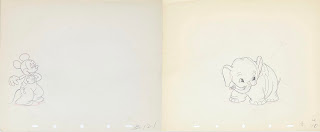Original production animation drawings of Mickey Mouse and Bobo the Elephant from "Mickey's Elephant," 1936, Walt Disney Studios; Graphite and red pencils on peg hole paper; Mickey Mouse numbered 121 & Bobo numbered 40 both in pencil lower right; Size - Mickey Mouse: 4 x 3", Bobo The Elephant: 3 3/4 x 4 1/2", Sheets 10 x 12"; Unframed.
"Oh boy! Won't Pluto be surprised when he sees you and your swell new house." - Mickey Mouse
To purchase these drawings or to visit the Art Gallery, CLICK HERE!
"Oh boy! Won't Pluto be surprised when he sees you and your swell new house." - Mickey Mouse
To purchase these drawings or to visit the Art Gallery, CLICK HERE!
"Mickey's Elephant" (originally released on October 10, 1936) is a Walt Disney Company animated short film that was distributed by United Artists. It was directed by Dave Hand and written by Vernon Stallings. The short is notable in that it was the first appearance of Bobo the Elephant from the Mickey Mouse newspaper comic strip and it is the only time that Pluto's Shoulder Devil appears without Pluto's Angel.
The
plot summary of "Mickey's Elephant" is that Mickey Mouse (voiced by Walt
Disney) receives a baby elephant named Bobo (voice by Lee Miller) from the Rajah of Gahboon. Pluto (voice by Lee Miller) is very skeptical Bobo and Pluto's Devil (voiced by Don Brodie) appears on his shoulder and convinces him that he is being replaced. To create trouble for the elephant, Pluto's shoulder devil spots some red pepper and convinces Pluto to blow it on Bobl causing his trunk to itch and making him sneeze.
Mickey tries to tend to Bobo, but to no avail, as he continues to uncontrollably sneeze and ends up accidentally destroying both his house and Pluto's doghouse. Pluto and Mickey are in shock, but the shoulder devil does not care and laughs at the destruction and misfortune. Pluto realizes he has made a terrible mistake and smacks the devil to the ground with his paw.
This is a pair of original production animation drawings of
Mickey
Mouse and Bobo from the 1936
Walt Disney short film "Mickey's Elephant." A great drawing set of Mickey Mouse and Bobo rendered
in graphite, red, and green pencils; and both images are full figure executed in exciting poses. These are rare pieces
of vintage Disney animation artwork, and would be a great addition to any
collection!



